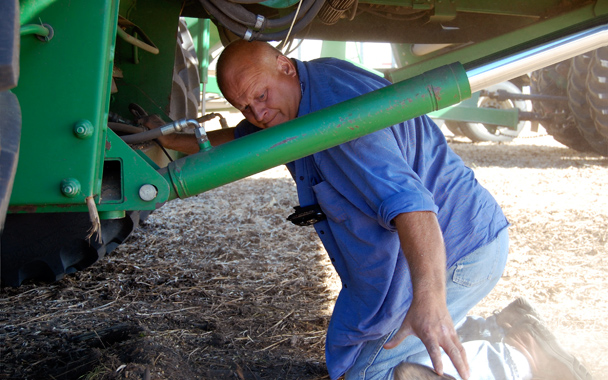As quickly as it began, the soybean harvest ground to a halt this week. Dale Hargens stumbled out of the gate first, breaking an auger in his combine while harvesting a neighbor’s field. He rushed to town for a quick $1,000 repair, only to break down again three days later. The second time it was the big front end auger on the combine—$5,000. The money is bad enough. What’s worse is that the clock keeps ticking.
“When I grew up, we owned two combines, and they were always breaking down,” Jim Lutter reflects, when told of Hargens’ travail. “I hate working on them.” Lutter resists buying a combine. It goes against his philosophy of only owning equipment that he can keep in use year round. But this week he can’t find a combine anywhere, can’t find a contract crew, can’t rent one. And the beans aren’t going to wait forever.
The last week has brought life’s fundamental dilemmas into sharp contrast for Lutter. On the ground, things are going pretty well. The buffalo round-up is finished. The cows have been preg-tested and turned out for the winter. He even turned his wandering bull out to pasture, confident that it would stay close by.
But when he tried to consolidate his credit at the local bank, he was turned down, and then came the dreaded call from North Carolina. Every year Lutter and his wife, Cindy, host a group of 20 businessmen from around the country for the opening day of pheasant season (October 18th). A real-estate investor from North Carolina organizes the group at $350 per hunter per day. That’s $7,000 a day for three days. The economy has gone bad, he is told. Everyone is cutting back. The group will only be six this year. In a flash Lutter sees his cash income drop almost $15,000. And now, the beans are ready and he can’t find a combine.
There’s also something else nagging at Jim Lutter this week. News arrived from in-laws in North Dakota. They’ve been at the soybean harvest for a week, and the yields are low, very low, mysteriously low. Less than 35 bushels an acre. Why? South Dakota farmers had hoped for 50 bushels. The USDA in Washington had estimated that 40 bushels would be the national average. But 35? When farmers are under stress, their eternal optimism turns to understatement. “We’re looking at yields a little less than we had hoped for.” Lutter says, and lets out a deep sigh.
Back in the saddle, Dale Hargens discovered the same numbers as Lutter. “I thought we had a shot at fifty. Now I hope we’ll make forty. One of my fields came in at thirty-five. If it hadn’t been for those three days of hot wind over Labor Day, we’d a had fifty.” Cruising through the dried soybean field, a rock hits the front auger. The whole combine shakes and chokes. Dale sits upright on the throne and grimaces. Sitting next to him, I can feel the shudder go through his body, that “not again” shudder. The combine digests the rock and moves on.
Charlie Johnson spent most of last week waiting. It rained two and a quarter inches Monday night, making it impossible to get into the soybeans for three days. He had a chance to combine 150 acres before the rains came, and what he learned churns the stomach and makes the waiting even harder. “Fifteen bushels an acre. We’re looking at the lowest yields we’ve had since two thousand and three, and that was the year we got hit by hail.” Why?
These are the moments when an organic farmer finds himself all alone. Lots of weeds this summer. Aphids? Maybe the sugar-water treatment didn’t work as well as he had hoped. Yeah, the Labor Day heat was bad, but not that bad. Johnson focuses on the heavy June rains. “The plants just didn’t set deep roots because of the rain. And the soil never got a chance to dry out.” Good thinking, but not good enough to explain a 15-bushel-an-acre harvest.
There is one other possibility. Farmers who grow commodity beans often plant five or even ten varieties. Some do great, some do lousy, but they are all mixed together when sold. Johnson’s organic client is very picky, and has selected only two varieties for him to plant, and those two must be harvested separately. There’s a whole lot riding on two seed varieties if they just don’t fit the soil.
Whatever the reason, this is one of those existential moments for Charlie Johnson. All the weed cutting, all the labor, hair-brained aphid control strategies, all the sideways glances from conventional farmers, for a 15-bushel yield! “Maybe organic just isn’t worth it,” says one little voice in his head. “No, no, it’s a philosophy, a way of seeing the land, a way of life,” says the other voice. “Yeah, but fifteen bushels an acre?” That’s why waiting is so lousy. Don’t obsess. Just get back in the field and face the verdict, then move on to corn.
Four more days of rain are in the forecast.
Did I mention that soybean prices have been in a free fall for the last few weeks? Dale Hargens sold beans for $12.50 a bushel last month. This week November contracts are set at $9.70. Falling prices, low yields. Whatever happened to the optimism of June?


